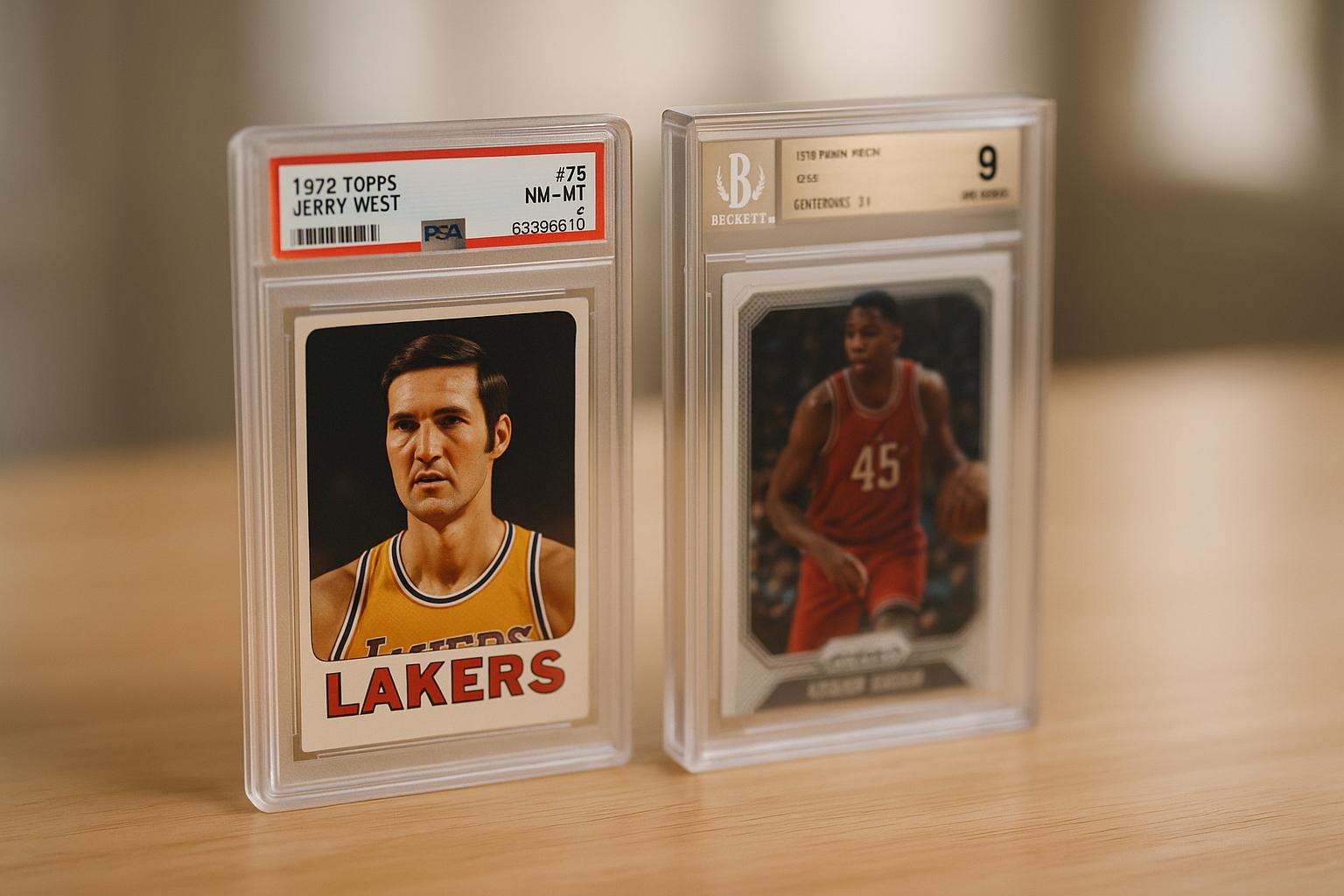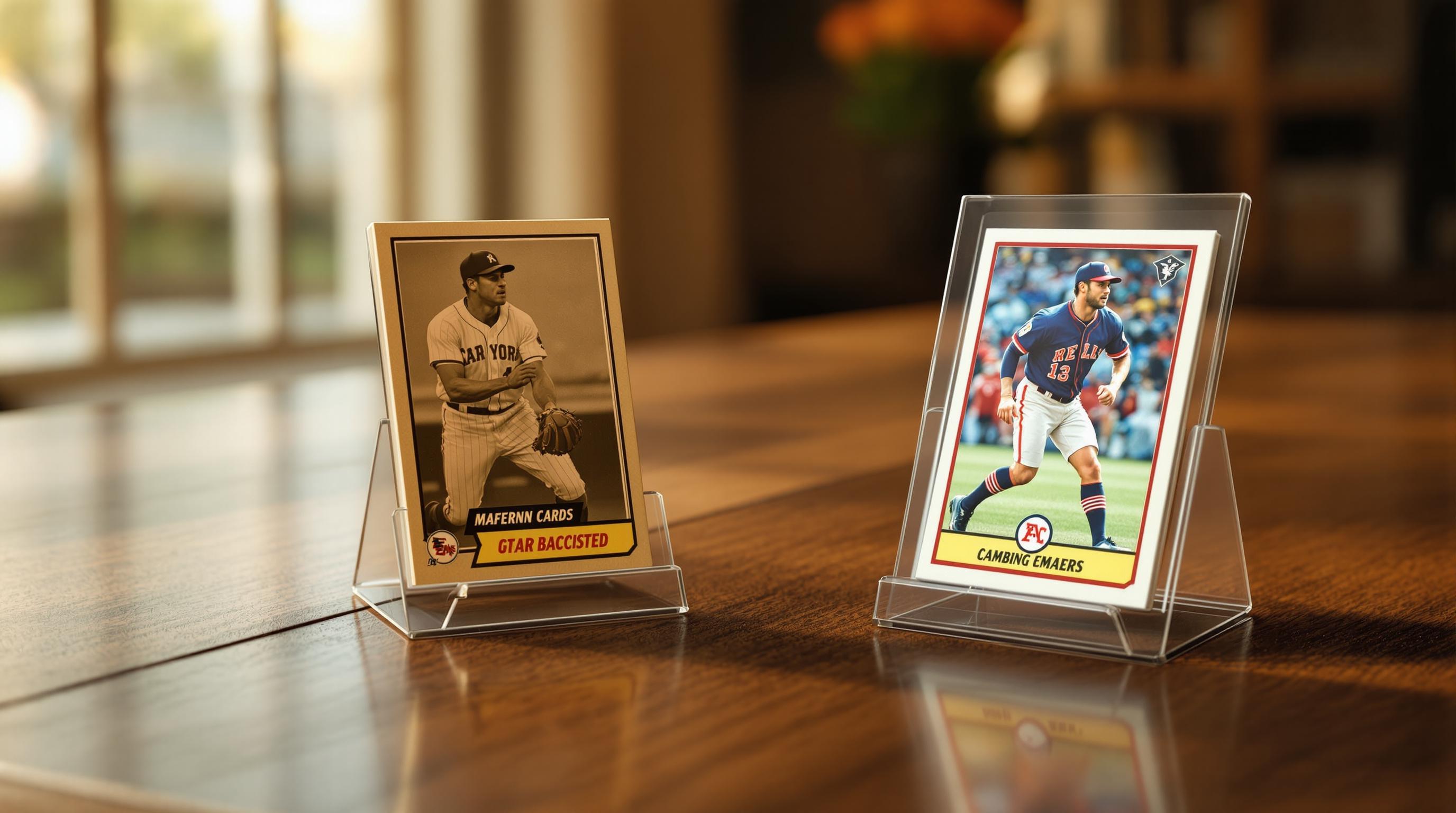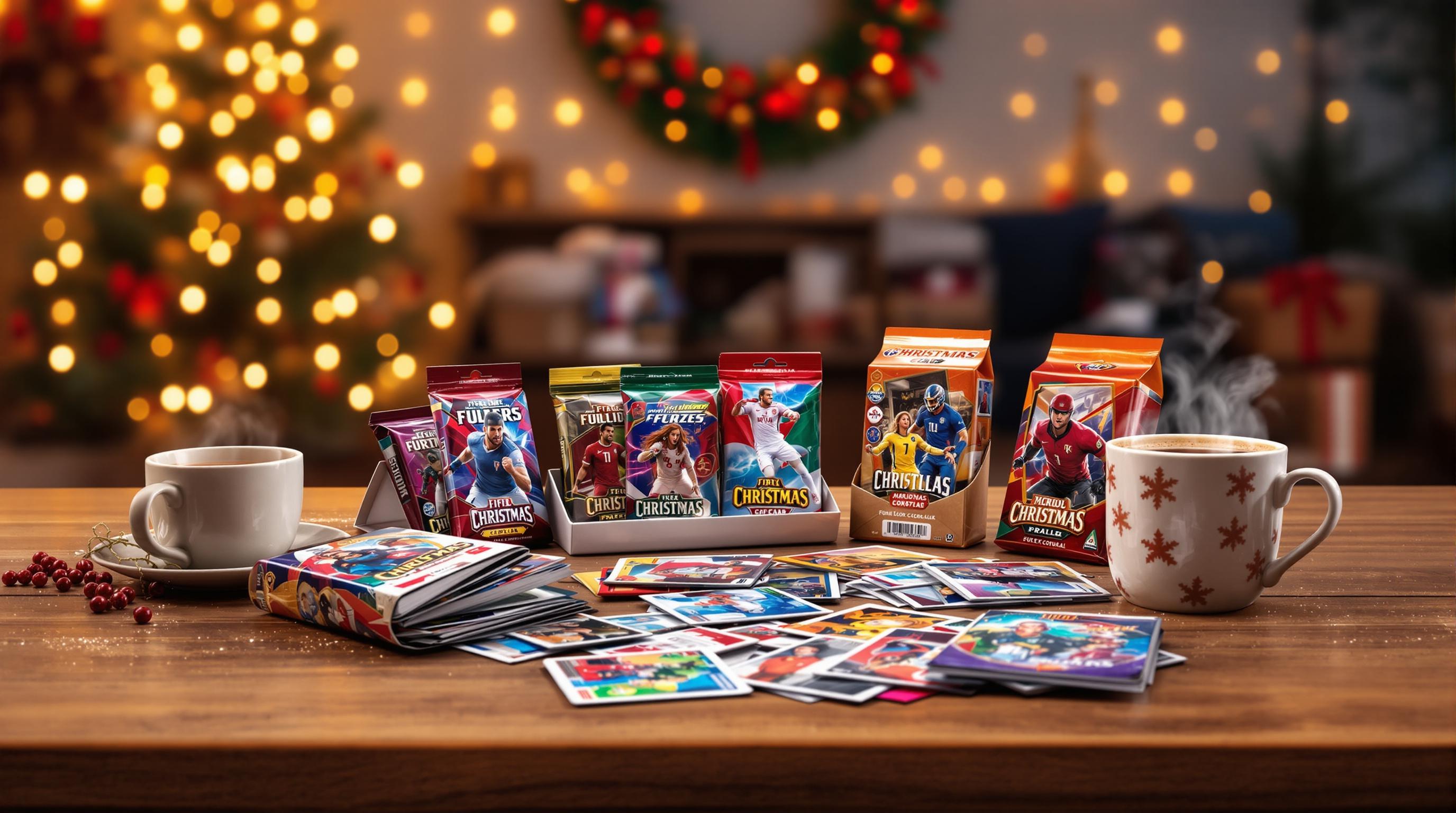If you’re holding onto 1990s basketball cards, you might be wondering: Are they worth anything in 2025? Here's the short answer: Yes, but it depends on factors like condition, rarity, and the player featured. Cards of legends like Michael Jordan, Kobe Bryant, and Shaquille O’Neal are in high demand, especially rare inserts and rookie cards in top condition.
Key points to know:
- Condition matters most: Professionally graded cards (PSA, BGS, SGC) in pristine condition fetch the highest prices.
- Player popularity drives value: Cards of iconic players are worth more, particularly rookie cards or those tied to career milestones.
- Rarity increases worth: Limited-edition inserts, parallels, and error cards from the 1990s are especially sought after.
- Market trends fluctuate: Nostalgia, social media buzz, and online sales platforms shape pricing.
For accurate valuations, local card shops, grading services, and online marketplaces are excellent resources. Tools like Card Shops List can connect you with experts who can appraise, grade, or help sell your collection. Proper storage and timing your sale around basketball season or major events can also maximize returns.
Top 50 Highest Selling 1990's Basketball Cards!
2025 Basketball Card Market: Current Trends
The basketball card market has shifted significantly, fueled by a wave of renewed interest from collectors. These days, it thrives across online platforms, grading services, and lively social media communities. Together, these elements shape the pricing trends we see today.
Market Trends Affecting Card Values
One of the biggest drivers of value is nostalgia. Collectors who grew up in the 1990s - now in their 30s and 40s - are returning to the hobby with more disposable income. This has led to a surge in demand for cards featuring iconic players like Michael Jordan and Kobe Bryant.
Social media is another force reshaping the market. Platforms like Instagram, YouTube, and TikTok create instant buzz around rare finds and record-breaking sales, driving up demand almost overnight.
Grading services have also become a game-changer. Collectors are now hyper-aware of card condition, and top-graded cards are commanding much higher prices.
Lastly, online marketplaces have made buying and selling more accessible than ever. However, they’ve also introduced price fluctuations, as recent sales directly influence a card's perceived value. This volatility is especially pronounced with 1990s basketball cards.
How Card Shops List Helps Navigate the Market

In this ever-changing landscape, Card Shops List is a trusted ally for collectors trying to make sense of the 2025 basketball card market. This directory connects hobbyists with local card shops specializing in sports cards, trading cards, and collectibles, offering access to experts who understand the nuances of both vintage and modern markets.
Local shops provide an invaluable service: in-person authentication. This allows collectors to inspect cards firsthand, ensuring they know exactly what they're buying. Many shops also offer consignment services, where experienced professionals help collectors sell their cards effectively.
Another standout feature is grading guidance. The directory highlights shops that can advise collectors on whether grading their cards will increase their value. This is especially important for 1990s cards, where even minor differences in condition can significantly impact pricing.
Card Shops List also showcases stores that host card breaks and group openings. These events bring collectors together, building a sense of community while offering an affordable way to acquire rare vintage cards that might otherwise be out of reach.
What Affects 1990s Basketball Card Values
The value of 1990s basketball cards hinges on three main factors. These elements, when considered alongside current market trends, paint a clearer picture of what drives card prices.
Player Fame and Career Impact
A player's career achievements and legacy play a huge role in determining card value. Legendary players often command the highest prices, especially when their careers include major milestones like championship wins. These events can cause card values to skyrocket almost overnight.
However, long-term value depends on how the player is remembered. For instance, players with a strong fan base or a "cult following" can maintain high card prices, even if their career stats don’t align with Hall of Fame standards. On the other hand, not all successful players see steady growth in card value. Rookie cards, for example, might start at almost nothing, peak during a player’s prime, and then decline later.
Interestingly, events like a player's death can also impact prices, sometimes causing sharp increases depending on the circumstances. These career dynamics naturally tie into the importance of card condition when assessing value.
Card Condition and Grading
The condition of a card is crucial. Even the rarest cards lose much of their worth if they’re damaged. Professional grading services, such as PSA, BGS, and SGC, are essential for determining a card’s value in today’s market. Grading uses a scale from 1 to 10, and even a single-point difference - like moving from a PSA 9 to a PSA 10 - can mean the difference between a $50 card and a $5,000 card.
To maximize value, premium cards typically need professional grading. Proper storage is equally important. Cards should be kept in protective sleeves and stored away from light, heat, and moisture to preserve their condition.
While condition is critical, rarity and unique features also play a significant role in a card’s worth.
Rarity and Special Features
Scarcity drives value. Cards with low print runs, serial numbers, or unique parallels often command premium prices. Insert cards and parallels featuring popular players are especially sought after due to their limited availability. Additionally, error cards can fetch high prices because of their uniqueness.
Rookie cards from the 1990s hold particular importance, especially when they’re in excellent condition. Getting these cards graded by services like PSA or Beckett can significantly boost their value.
Ultimately, the interplay between a player’s legacy, the card’s condition, and its rarity determines its worth. For example, a well-preserved common card of a legendary player can be worth more than a rare insert of a lesser-known player in poor condition. Understanding how these factors work together is key to identifying the most valuable cards in your collection.
High-Value 1990s Basketball Cards in 2025
The 1990s were an iconic decade for basketball cards, and some of those treasures are still commanding impressive prices at auctions today. Let’s take a closer look at the cards and editions that are driving collector demand in 2025.
Top Cards and Recent Sale Prices
Cards featuring basketball legends like Michael Jordan remain the crown jewels of the era. High-grade versions, especially premium refractor editions, consistently fetch top dollar. Other standout players from the decade, such as Kobe Bryant, Tim Duncan, and Shaquille O’Neal, also see strong market performance. Cards in pristine condition - graded by top companies - are especially sought after by collectors.
Rare Inserts and Parallels Worth Finding
For serious collectors, rare inserts and limited parallels from 1990s sets are a major focus. Parallels, known for their limited print runs or distinctive designs, are highly valued for their scarcity. Inserts with unique finishes or intricate designs also hold strong appeal and can be lucrative investments. Even slight differences in card grading can significantly impact their market value, making attention to detail critical for buyers and sellers alike.
sbb-itb-0db97a5
Tools for Evaluating Your Collection
Getting a professional appraisal is a smart way to determine the value of your 1990s basketball cards. Local experts can provide market-based insights that are both accurate and trustworthy. A great starting point is Card Shops List, which helps you connect with knowledgeable appraisers in your area.
Grading Services and Population Reports
Grading services like PSA, BGS, and SGC are essential for assessing the condition of your cards. These companies use a standardized scale from 1 to 10, with higher grades often leading to higher prices. Additionally, they offer population reports, which tell you how many cards have received specific grades. This data is invaluable for understanding both the rarity and market position of your collection.
Online Price Guides and Marketplaces
Online platforms provide up-to-date pricing based on recent sales and active listings. These tools are excellent for spotting trends and comparing card values across different conditions and variations. Keep in mind, though, that prices can change quickly. To get a more reliable estimate, it’s a good idea to check multiple sources and cross-reference the data.
Finding Appraisals Through Card Shops List
Local card shops are another excellent resource for personalized appraisals. Shop owners often have extensive knowledge of the market and can offer tailored evaluations for your collection. Card Shops List connects you with dealers who can help with appraisals for purposes like insurance, estate planning, or preparing for a sale. Some dealers even provide free evaluations for smaller collections, though larger ones might come with a fee.
How to Get Maximum Value from Your Collection
Getting the most out of your 1990s basketball cards takes a mix of careful preservation, smart selling strategies, and well-timed decisions. A pristine card can fetch far more than one that's been mishandled, with differences in value sometimes reaching thousands of dollars.
Keeping Cards in Good Condition
The condition of your cards is everything. Start by storing them in polypropylene or polyethylene penny sleeves - never use PVC as it can damage the cards over time. For added protection, place them in top loaders or magnetic holders. For especially valuable cards, consider card savers, which are ideal for grading submissions.
Keep your cards in a climate-controlled space, maintaining a temperature of 65–70°F and humidity levels between 45–55%. Avoid storing them in basements, attics, or garages where temperatures and humidity can fluctuate. Direct sunlight is another danger - it can fade cards in just a few months. Instead, store your collection in dark or low-light areas to prevent damage.
When handling your cards, always use clean, dry hands and hold them by the edges. Avoid using rubber bands or paper clips, as these can cause permanent damage that significantly lowers their value. Once your cards are properly preserved, it's time to focus on the best way to sell them.
Best Ways to Sell Your Cards
Choosing the right selling method depends on the value of your cards. For high-value cards worth over $500, auction houses and graded card marketplaces are excellent options. These platforms attract serious collectors who are willing to pay top dollar, though they typically charge fees ranging from 8–20%.
If you’re looking for convenience, local card shops are a solid choice, especially for mid-range collections or when you need quick cash. Use resources like Card Shops List to find reputable dealers in your area. Many shops also offer consignment services, where they sell your cards on your behalf for a percentage of the final sale price.
For collections with a mix of values, consider breaking them into smaller lots based on player, team, or card type. This approach often brings in more money than selling everything as one large group. Make sure to photograph your cards clearly and provide detailed descriptions, noting any flaws. Transparency builds trust and can lead to better offers.
When to Sell and How to Avoid Scams
Timing is key when selling basketball cards. Prices often rise during basketball season, especially around playoff time or when players hit major milestones. Cards of players whose teams are in the playoffs or who achieve career highlights can see temporary price spikes. However, waiting too long for the "perfect" moment can backfire, as market trends can shift quickly.
Protect yourself from scams by being cautious of buyers offering prices that seem too good to be true or requesting unusual payment methods like wire transfers or cryptocurrency. Most legitimate buyers prefer PayPal, certified checks, or cash for in-person deals. Always check a buyer’s reputation by reviewing feedback and transaction history before agreeing to a sale, especially for high-value items.
For shipments over $50, use secure packaging and include tracking, insurance, and signature confirmation to protect your valuable cards.
Authentication is essential in today’s market. Graded cards from trusted services like PSA, BGS, or SGC are often easier to sell and fetch higher prices. If you’re selling raw cards, provide detailed photos and an honest assessment of their condition. Misrepresenting a card can lead to returns, bad reviews, or even legal trouble.
Finally, research recent sales of similar cards to set a fair asking price. The market can change quickly, so yesterday’s prices might not apply today. Be flexible but realistic when pricing your cards to align with current trends.
Getting the Most from Your 1990s Basketball Cards
If you're holding onto 1990s basketball cards in 2025, you might be sitting on a treasure trove. Preserving their condition and choosing the right selling strategy can make all the difference. The cards that fetch the highest prices are typically those featuring star players, boasting pristine condition, and standing out in terms of rarity.
A player’s legacy plays a huge role in determining a card’s value. For instance, cards featuring iconic players like Michael Jordan remain highly coveted. Rookie cards of big-name stars are especially prized, while cards of legends like Tim Duncan and Kevin Garnett continue to draw collector interest. Additionally, cards graded at the highest level by professional services often command significantly higher prices than those with lower grades.
Rarity is another key factor in boosting value. Insert cards, refractors, and low-numbered parallels from the late 1990s are particularly desirable. Sets like Metal Universe Precious Metal Gems are prime examples of how scarcity drives up prices. Even lesser-known inserts, such as select cards from the Skybox series, can hold surprising value - especially when kept in flawless condition.
Professional grading is crucial for maximizing a card’s worth. Services like PSA, BGS, and SGC not only authenticate and grade your cards but also provide population reports. These reports show how rare your card is compared to others with the same grade, which directly influences its market value.
When it’s time to sell, timing and platform choice are critical. Interest in basketball cards tends to spike during major events like the playoffs. For high-value cards, auction platforms or specialized marketplaces are often the best options, even though they come with fees. For quicker sales or mid-tier collections, local card shops can be a solid option. Platforms like Card Shops List can help you find reputable dealers who offer fair pricing and consignment services.
FAQs
How can I tell if my 1990s basketball cards are rare or valuable?
To determine whether your 1990s basketball cards hold any real value, start by examining them for special features. Look for things like serial numbers, autographs, error cards, or unique inserts - such as refractors or foil designs - that were often produced in small quantities. Cards that include game-used memorabilia or showcase Hall of Fame players or iconic rookie seasons are especially desirable among collectors.
The condition of the card is equally important. Cards graded as PSA 10 (gem mint) are typically the most valuable, particularly if they come from a limited print run. Carefully inspect your collection for these details to get a clearer picture of its potential value.
How can I keep my 1990s basketball cards in great condition to maintain their value?
To ensure your 1990s basketball cards stay in great shape and maintain their value, proper storage is key. Use protective sleeves, top loaders, or hard cases to shield them from bending, scratching, or other types of physical damage. When handling the cards, make sure your hands are clean and dry, and try not to touch the card surfaces directly - this helps prevent oils or dirt from causing harm.
Store your collection in a cool, dry, and dark place to guard against humidity, heat, and light exposure, which can lead to fading or warping over time. Avoid stacking unprotected cards, and take the time to occasionally check on your storage setup to ensure the conditions remain ideal. These straightforward practices can help keep your collection in excellent condition for years to come.
How do social media and online marketplaces affect the value of 1990s basketball cards in 2025?
Social media and online marketplaces have a huge influence on the value of 1990s basketball cards in 2025. Platforms like YouTube, Instagram, and TikTok often ignite trends, with influencers highlighting rare or iconic cards. When these moments go viral, they can create a surge in demand, driving up interest and, of course, prices. A single post or video can suddenly make a specific player or card set the focus of collectors everywhere.
Meanwhile, online marketplaces have opened up the world of trading cards to a global audience. This accessibility means more competition among buyers, which often pushes prices higher for highly sought-after cards - especially those in pristine condition or featuring legendary players. That said, this global exposure also adds a layer of unpredictability, as prices can swing quickly based on shifting trends and collector enthusiasm.


